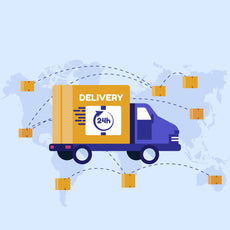Keeping costs under control is a constant challenge, whether you're in landscaping, construction, or gardening. Sometimes, it's the smaller decisions, like selecting the right kind of wheelbarrow tire, that can have a significant impact over time.
Surprisingly, these decisions can lead to savings in ways you might not expect.
If you're still using traditional pneumatic tires, they may seem like a cheaper option at first. However, opting for flat-free tires is a wise investment that can help you save much more in the long run. In this article, we'll explore how switching to flat-free tires can help cut ongoing costs, increase productivity, and ultimately save your business money—well beyond their initial purchase cost.
The Hidden Costs of Traditional Pneumatic Tires
Pneumatic tires are a popular choice because they're affordable and easy to replace. But what might seem like a low-cost option hides some significant expenses that tend to sneak up on you. Here's why:
You're Replacing Them More Often Than You Realize
Flat tires are a constant headache, especially on job sites or in rugged outdoor conditions.
Whether it's a random nail, a jagged rock, or just the usual wear and tear, you're stuck paying for repairs or replacements every time a tire gets punctured.
Sure, one flat might not seem like a big deal, but when it becomes routine, those costs start stacking up fast.
Think about it: if you're dealing with a flat tire every couple of months, you're not just paying for the tire itself. There's the added cost of having that wheelbarrow or equipment out of commission while it gets fixed. It's not just an inconvenience—it's time that could have been spent working, which in turn affects your profits.
Repairs Take Time—And Time Costs Money
Even if you're not replacing the tire outright, a flat always means downtime. Even a quick patch or tire swap still takes up valuable time. And when you factor in labor costs, that downtime turns into a hidden expense. A single flat can bring your whole team to a standstill, which slows down progress on the project.
There's also the hassle of getting it fixed, whether it's spending money on patch kits, inflating or deflating the tires, or sending someone to grab a replacement. None of this is free. For bigger operations managing multiple wheelbarrows or heavy equipment, that time loss can spiral into larger delays, eating into your bottom line.
Downtime Hurts Deadlines
When your team stops to deal with flat tires, the whole project takes a hit. For businesses working on tight schedules—like landscapers juggling multiple jobs or construction crews with hard deadlines—those delays don't just feel frustrating; they hurt your bottom line. Missing deadlines can cost you, whether it's in penalties for being late or missing out on future gigs because of project setbacks.
Let's say your team deals with just one flat tire a month. If each replacement sets you back $20, that's already $240 a year on tires alone. And that doesn't include the downtime and labor hours it took to fix the problem. Over time, these costs snowball, and suddenly, you're losing hundreds of dollars—money that could have been better spent elsewhere.
Why Flat-Free Tires Are a Better Investment
Yes, flat-free tires cost more upfront. But their long-term savings far outweigh the initial investment. Here's why they're worth it, even if you feel a pinch when making that first purchase:
They Last Longer—Much Longer
Flat-free tires are built to withstand the toughest conditions. Made from solid materials like polyurethane, these tires are designed to handle rough terrain and heavy loads without getting damaged. You don't have to worry about punctures, blowouts, or constant replacements. In short, they're built for hard work.
- No More Flats: Because these tires are immune to punctures, you won't need to repair or replace them nearly as often, if at all. There's no worrying about stray nails or sharp gravel getting in the way of the job.
- Fewer Replacements: A flat-free tire can easily last for years, even in harsh conditions. This means you're not stuck buying new tires every few months or even every year.
If you're replacing pneumatic tires thrice a year at $20 a pop, that's $60 annually per wheelbarrow. A flat-free tire might cost $50 upfront but could last five years or more. In that time, you're saving at least $250 on tire costs alone—and that's just for one wheelbarrow.
Now, imagine you have multiple wheelbarrows or a whole fleet of equipment. The savings multiply fast.
Forget About Maintenance and Repairs
Pneumatic tires come with a constant maintenance routine. You're checking air pressure, fixing leaks, and keeping patch kits on hand for when things go wrong. Flat-free tires, on the other hand, require none of that. Once they're on, they're good to go—no fuss, no ongoing costs.
Flat-free tires don't need to be patched or refilled, so you won't have to spend extra money on supplies.
Save on Labor
Your workers won't be wasting time fixing flats. Instead, they'll spend more time working, which means more productivity for the business.
More Jobs, Done Faster
Flat-free tires can also make your team more efficient. And more efficiency means more jobs completed on time, leading to more revenue for your business.
Employees can transport more material per round—whether it's gravel, soil, or concrete—thereby saving the time that they would have spent hauling items back and forth across the job site.
Suppose your team pulled through 2-3 hours a week due to the absence of tire problems. That will come to about 120 hours in a year saved. But if we consider that you have a labor rate of $25 per hour.
This is $3,000 a year just by not taking the downtime into account and this doesn't even include the jobs you could do with that extra time.
Better Safety Means Lower Costs
Long-term sustainability and safety are other major issues that have to be discussed. When it comes to safety, flat-free tires ensure more secure working conditions due to reduced accident rates. In such a way, fewer accidents will also result in less injuries, reduced downtime, and lower costs.
Fewer Accidents
Flat tires are not merely bothersome—they are safety hazards too. A tire that is blown away when carrying a load, it may lean on its side, create spills, or hurt someone. In comparison to traditional ones, the flat-free tires are highly structured and most importantly improve stability so decreases are thus achieved even on uneven surfaces.
Reduced Injury Costs
According to statistics, injuries in the workplace can result in the company in terms of medical expenses, insurance claims, and loss of work time, not to mention the possibility of getting penalized thus workers compensation.
With one workplace injury, you might have to secure your company finances with thousands of dollars of insurance claims, the unproductivity of the work staff, and all the medical bills that the injured employee has to pay.
Avoiding just one severe accident by introducing innovation like flat-free tires could not only bridge the initial outlay but would also leave you in profit heaven.
Avoid Wasting Materials
Imagine a wheelbarrow falling on a garden because it got a flat tyre. Not only will you waste time but also the materials which you have arranged on the site.
The materials that you cause will lead to increased costs, be it a mixture of cement, high-value crops, or a load of machinery. However, no-spill tires could help you improve such scenarios and protect the project sidewalk.
The use of solid tires can mitigate the risks of spills or blowouts, hence your company could save more money over time.
Savings Over Time
First, let's overview the actual cost. We buy pneumatic tires for $20 each and need them replaced about three times a year: that's already $60 a year just for one wheelbarrow.
Let us consider the expense related to the cost of the patch kits, tubes, and other repair supplies: You're looking at an additional $100 in maintenance costs every year.
One of the time-consuming issues is downtime. Assuming the employees devote at least 15 hours per year to the problem of flat tires, we can conclude that 15 hours is the time when they are not working productively. Let's say you pay $25/hour to them. Only $375 is lost due to downtime.
At the end of the year, the dollars are almost $180 per year on tires, repairs, and lost productivity—otimizes the indirect costs of postponed deadlines and load factors. Savings with the same size of equipment and the project may be close to $180.000 per year.
These solutions improve the internal quality in the firm as they free external time from outside beacons.
Imagine comparing it to flat-free tires. A single tire costs you about $50 but it could last you six years or more which is why you have lower total costs. For example, at that time, no replacements, maintenance, or downtime expenses are incurred.
By avoiding the investment in flat-free tires, more of the money could be returned to your business rather than being lost to the costs that can be avoided.
Conclusion
When you are running a business, you need to consider the cost of everything. It could be easy temptation to go for cheaper pneumatic tires but if we look at the long-term benefits of flat-free tires, you will definitely see their advantages over the old ones, and this will make you change your mind.
These tires allow you to forget about the flat tires issue, cut down on the maintenance cost and keep your team working effectively — without the interruptions caused by the flat tires that belong to the traditional types.
When you are a cost-conscious entrepreneur and money-saving is your goal, you will make sure to compare cost factors, production time, or human safety before making a decision and the cost-effective mechanism of flat-free tires are the right choice.
True, it might cause a few more dollars in the beginning but the over-all savings are more than what you have invested in. Accordingly, they're not only a money-saver but a factor for the smooth operation of your entire company.



